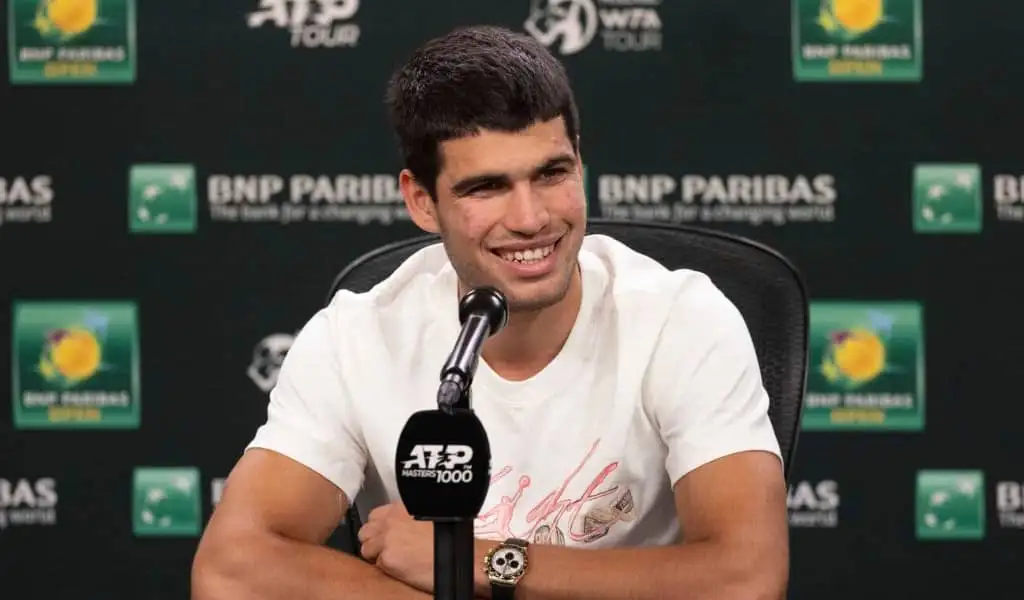
On a sun-kissed afternoon in Monte Carlo, April 9, 2025, Carlos Alcaraz, the 21-year-old Spanish tennis prodigy, stepped onto the clay courts of the Rolex Monte Carlo Masters with the weight of expectation pressing down on him. The world No. 3, a four-time Grand Slam champion and the defending French Open king, faced Argentina’s Francisco Cerundolo in a second-round showdown that tested his mettle. What unfolded was a rollercoaster of a match—a shaky start that saw him drop the first set 3-6, followed by a breathtaking resurgence as he roared back to claim a 6-0, 6-1 victory. Post-match, Alcaraz peeled back the curtain on his rocky beginning and the pivotal tweak that turned the tide, offering fans a glimpse into the mind of a champion who thrives on adaptation.
The opening set was a wake-up call for Alcaraz. Fresh off a first-round bye as the tournament’s second seed, he found himself out of sync against Cerundolo, a clay-court grinder ranked No. 22 who’s racked up more wins than anyone on the ATP Tour this year. “I didn’t start well. I made a lot of mistakes and I let him play inside the court, dominating the points,” Alcaraz reflected, his tone carrying the sting of self-awareness. Cerundolo pounced, breaking the Spaniard’s serve twice with a blend of patience and precision, dictating rallies while Alcaraz’s shots veered off course. For a player who’s made a career of dazzling crowds with his explosive athleticism and flair, this was an uncharacteristic stumble—a moment where the clay, his supposed sanctuary, felt more like quicksand.
But Alcaraz is no stranger to digging himself out of holes. The second set began with a precarious hold of serve, fending off two break points that could have deepened his deficit. That gritty stand sparked a transformation. “I just knew that I had to do something else, play more aggressively, and play my own tennis: drop shots, going to the net, and more aggression,” he explained, laying out the blueprint for his comeback. Stepping closer to the baseline, he unleashed the full arsenal of his game—drop shots that kissed the net cord, volleys that danced out of reach, and a forehand that found its venom. The adjustment was stark: his first-serve return success soared by 44 percent, flipping the script as he wrested control from Cerundolo. What followed was a demolition—11 of the next 12 games went his way, leaving the Argentine scrambling and the Monte Carlo crowd roaring.
For Alcaraz, the key to unlocking his dominance lay in one critical shift. “The most important change was the return; I tried to return closer to the line and push him,” he revealed, pinpointing the tactical pivot that turned a potential upset into a rout. By hugging the baseline, he shrank Cerundolo’s window to maneuver, forcing errors and seizing the initiative. It was a move born of instinct and honed by years on clay, where he’s claimed eight of his 17 career titles. “I missed clay,” he scribbled on the camera lens after the match, a heartfelt nod to the surface that’s shaped his rise from a Murcia teenager to a global superstar. This win—his first ever at Monte Carlo after an injury-plagued absence last year—felt like a homecoming, a chance to banish the ghosts of a 2022 second-round exit and a string of recent hard-court hiccups.
The victory wasn’t just a personal milestone; it was a lifeline in a season of uneven footing. After a Rotterdam title in February, Alcaraz has weathered a storm of setbacks—a quarter-final loss to Novak Djokovic at the Australian Open, a semifinal defeat to Jack Draper at Indian Wells, and an opening-round shocker against David Goffin in Miami. Monte Carlo offered a clean slate, and he seized it with both hands. Now, he advances to face Germany’s Daniel Altmaier in the third round, a qualifier he dispatched in straight sets five years ago on the Challenger circuit. With no points to defend from last year’s absence, every step forward is a chance to climb closer to the No. 1 spot, currently held by the suspended Jannik Sinner.
As the clay season unfurls, Alcaraz’s Monte Carlo resurgence is a harbinger of what’s to come. This wasn’t just a win—it was a declaration of intent, a reminder of why he’s the heir apparent to Rafael Nadal’s clay-court throne. “I’m really happy with the way I’m playing,” he’d said earlier in the week, a confidence that shone through as he shook off the rust and rediscovered his rhythm. For a player who thrives under pressure, the shaky start was merely a spark; the adjustment, a flame. As he strides deeper into the tournament, the tennis world watches, captivated by a young star who turns stumbles into strides, one audacious shot at a time.
Leave a Reply